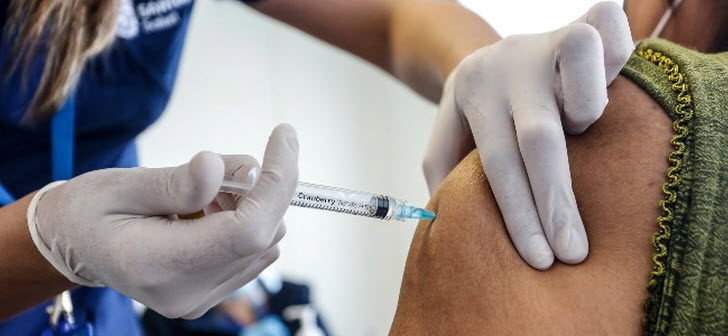-
fromVivian Werg
Close
The number of skin cancer cases has been increasing for years – how can you check your skin for malignant changes.
Kassel – Cancer is a widespread disease. Skin cancer is one of the most common types of cancer. According to the German Cancer Help About 304,000 people are diagnosed in Germany each year. The number of diseases has been increasing exponentially for years. Overuse of UV rays is one of the most important risk factors for the development of skin cancer.
The cancer is more common in people who work outdoors, exercise, or sunbathe frequently. MSD Handbook According to them, people with fair skin are particularly susceptible to most forms of skin cancer because they produce less melanin. The protective pigment in the outermost layer of the skin, helps protect the skin from ultraviolet (UV) radiation.
However, most skin cancers are curable, especially if the cancer is caught early and treated early. The so-called “ABCDE rule” is often used to detect the first signs of skin cancer.
Early detection of malignant birthmarks: Regular check-ups are important in order to treat potential skin cancer at an early stage (icon)
© Imago
Skin cancer detection – with the ABCDE rule
like German Cancer Help Knowing that most of those affected develop light or white skin cancer, which rarely forms secondary tumors and is therefore relatively less threatening than black skin cancer, malignant melanoma. Therefore, it is important to monitor birthmarks and moles, the so-called pigment marks, and pay attention to changes in the skin. However, changes can also occur in areas of skin not exposed to the sun.
The ABCDE rule can help better classify skin abnormalities. Each letter stands for a characteristic that a pigmented skin lesion, for example a mole, can have:
- A for asymmetryCheck skin lesions such as moles to see if they are of a regular round or oval shape. If it is uneven, that is, asymmetric, you should consult a dermatologist.
- b as limit: The edges of harmless birthmarks and pigment spots are sharply and smoothly defined. On the other hand, if the edges look washed out, jagged, uneven and/or jagged, an examination by a dermatologist is recommended urgently.
- c like color: Look for a spot that is not evenly colored but mixed with pink, gray, or black dots. It indicates malignant melanoma and should always be checked by a doctor. The same goes for the crispy toppings.
- d as diameter: If the diameter of the skin lesion is more than three to five millimeters or if the shape is hemispherical, you should consult a dermatologist as soon as possible.
- E for greatness: If the mole protrudes more than a millimeter above the level of the skin and has a rough or scaly surface, this may also be a sign of skin cancer.
- Source: German Cancer Society, Netdoktor.de
If at least one of the following characteristics applies, the mole should be shown to a doctor and examined as soon as possible. Basically, it’s better to have anomalies that bother you again than it’s too late. If an existing mole changes size, shape, or color, and begins to itch or bleed, see a dermatologist immediately, she advises. German Cancer Society.
Carcinogenic viruses: These pathogens can cause cancer




Skin cancer: These factors increase the risk of developing the disease
Even if the ABCDE rule can provide the treating dermatologist with important information, experts recommend regular check-ups by a doctor. Only he can make the final diagnosis. like consumer center Since July 2008, there has been a national program for early detection of skin cancer. Thus, all those with statutory health insurance from the age of 35 are entitled to a free skin cancer examination at the doctor every two years.
high MSD Handbook According to the study, your risk of developing skin cancer is higher if you:
- I had frequent sunburns, especially in childhood and adolescence.
- Go to the solarium regularly.
- You have a lot of pigmented moles.
- You have a weak immune system.
- Has skin cancer previously occurred in your family.
Contrary to the assumption that artificial ultraviolet radiation from a solarium is healthier than natural radiation from the sun, the World Health Organization (WHO) has classified natural ultraviolet radiation from the sun and artificial ultraviolet radiation from a solarium into the highest category of causative agents. for cancer. This means that it is classified as carcinogenic as tobacco.
Editor’s note:
The information in this article does not replace a visit to your doctor. Only experts can make the correct diagnosis and start appropriate treatment. You should discuss taking medications or nutritional supplements with your doctor beforehand.
You can greatly reduce your risk of skin cancer if you avoid strong sunlight (midday sun), use a sunscreen with adequate UVA protection while also paying attention to sun protection for your fabric. You should also not expose sunscreen to extreme heat – toxic substances can develop. Old sunscreens can also reduce the effectiveness of UV protection. If your sunburn occurs despite sunscreen, simple home remedies can help. Some treatments should be avoided if you have a sunburn. (Vivian Werg)
List of rules: © Imago

“Total coffee aficionado. Travel buff. Music ninja. Bacon nerd. Beeraholic.”







More Stories
New vaccine against dengue fever » Latinapress News
An Earth-sized planet near a small star
“The Hand of God” reaches the galaxy – new images from space